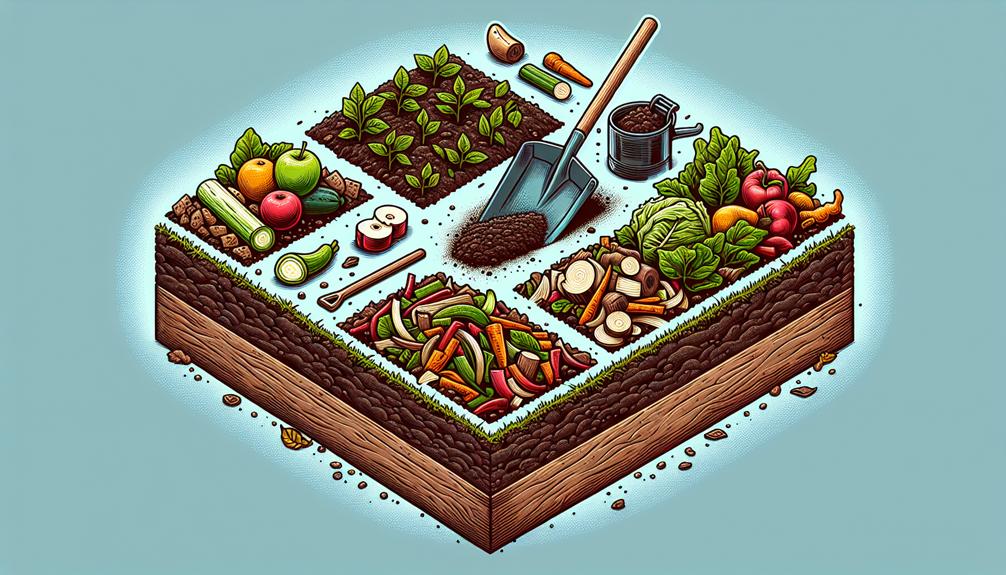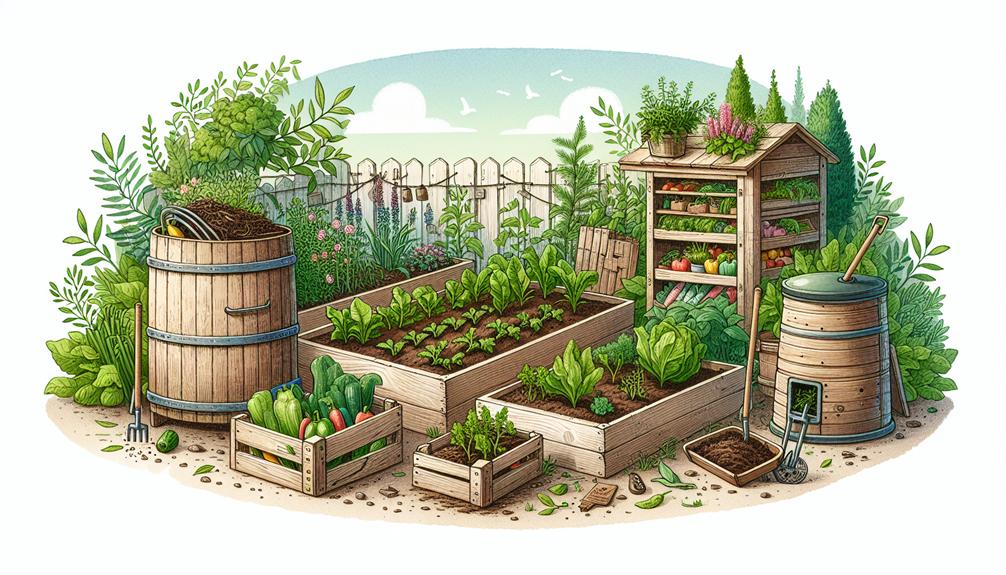Imagine your square foot garden thriving with rich, dark compost that you made yourself.
The key to a successful garden lies in the quality of your soil, and compost is the perfect way to enrich it.
Whether you’re a seasoned gardener or just starting out, these DIY compost solutions will help you create nutrient-rich soil that will yield bountiful harvests.
1. Trench Composting

Have you ever wondered how to efficiently compost organic waste directly in your garden beds? Trench composting is a practical and effective solution for enriching your soil and promoting microbial activity right in your square foot gardens.
To get started, choose a section of your garden where you want to improve the soil. Dig a trench about 12 inches deep and 8 inches wide. As you go about your gardening activities, such as weeding or trimming plants, simply place the organic waste directly into the trench. This waste can include fruit and vegetable scraps, coffee grounds, tea bags, and eggshells, but avoid adding meat, dairy, or oily foods. Cover the waste with a thin layer of soil after each addition to keep pests away and aid in the decomposition process.
Microbial activity will break down the organic matter, converting it into nutrient-rich soil. This process not only enriches the soil but also improves its structure and water retention capabilities.
Trench composting is a simple and efficient way to recycle organic waste while naturally enhancing the quality of your garden soil.
2. Worm Bin Composting
Trench composting offers a natural and effective way to enrich your square foot garden soil.
Now, let’s shift our focus to worm bin composting. Vermicomposting, or worm bin composting, is a practical and efficient method to recycle kitchen scraps and garden waste into nutrient-rich compost for your square foot garden.
The benefits of vermicomposting are numerous. Worm castings, the byproduct of vermicomposting, are a powerful organic fertilizer that improves soil structure, enhances drainage, and boosts plant growth.
Setting up a vermicomposting system is relatively simple. You’ll need a suitable container, such as a plastic bin with a lid, bedding material like shredded newspaper or cardboard, and composting worms. Red wigglers are the most commonly used species for vermicomposting.
Place the bedding and worms in the container, add your kitchen scraps, and keep the bin in a cool, shady spot. Ensure proper moisture levels and aeration, and your worms will diligently turn organic waste into dark, crumbly, and nutrient-dense compost.
With a well-maintained worm bin, you can continuously produce high-quality compost to nourish your square foot garden.
3. Pallet Compost Bin

Consider utilizing a pallet to construct a cost-effective and practical compost bin for your square foot garden. Pallet repurposing is an excellent way to create a composting solution for urban gardening and effectively manage garden waste.
To create a pallet compost bin, start by securing four pallets of the same size. Stand the pallets on their sides and attach them together using screws or heavy-duty zip ties. Ensure that the pallets are secure and stable to contain the compost materials. This method allows for good airflow and easy access to turn the compost.
When choosing a location for your pallet compost bin, make sure it’s in a convenient spot for adding and turning the compost, and that it receives adequate sunlight. Remember to layer your green and brown materials, and turn the compost regularly to aerate it.
The pallet compost bin provides a practical and affordable solution for composting in small spaces, making it an ideal choice for square foot gardens and urban gardening.
4. Compost Tumbler
Repurposing materials from urban environments for compost solutions, such as the pallet compost bin, provides a practical segue into the utilization of a compost tumbler for efficient composting in square foot gardens.
A compost tumbler is a cylindrical container that can be rotated to mix and aerate the composting materials, accelerating the decomposition process. Here are some key benefits and tips for using a compost tumbler:
- Convenient and Efficient: The compost tumbler offers a convenient solution for indoor composting, making it ideal for apartment dwellers with limited outdoor space. Its rotating mechanism ensures thorough mixing and aeration, leading to faster decomposition of organic matter.
- Reducing Common Mistakes: One common mistake in composting isn’t achieving the right balance of carbon and nitrogen-rich materials. With a compost tumbler, it’s easier to monitor and adjust the mix, reducing the likelihood of imbalanced compost. Additionally, the enclosed design helps prevent odor issues often associated with traditional compost piles.
- Space-Saving Design: The compact nature of compost tumblers makes them excellent for small gardens or balconies. They also deter pests and rodents, making them a practical choice for urban environments.
Incorporating a compost tumbler into your square foot garden can streamline the composting process and provide nutrient-rich soil for your plants.

